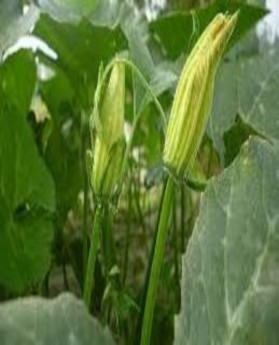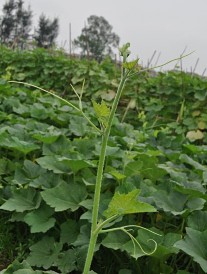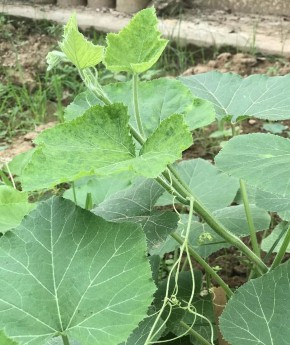gourd) as viewed with high frequency oligonucleotide-targeting active gene (HFO-TAG) markers", Genet. Resour. Crop Evol., 62, pp 1095 - 1111.
90. Paulauskiene, A., Danilcenko, H., Pranckietiene, I., Taraseviciene, Z. (2018), Effect of different fertilizer on the mineral content of pumpkin fruit. J. Elem, 23, pp 1033-1042.
91. Pradeepika C., V.D. Gasti, T. Vardihini Kumari, Evor S.C (2017), "Per se perfomance of pumpkin gennotype", Environment and Ecology 35 (1), pp 51 -54.
92. R.R. Sokal, C.D. Michener., (1958), A statistical method for evaluating systematic relationships. University of Kansas Scientific Bulletin, 1958, 28, pp 1409 - 1438.
93. Rebeca Lourenço de Oliveira, Leandro Simões Azeredo Gonçalves, Rosana Rodrigues (2016), "Genetic divergence among pumpkin landraces", Ciências Agrárias, Londrina, Vol. 37 (2), pp 547 - 556.
94. Rfos H., Labrada, A Fernéndez and E. Casanova Galarraga (1998), “Tropical pumpkin (Cucurbita moschata) for marginal conditions: breeding for stress interactions”, Plant Genetic Resources Newsletter.
95. Robinson R. W., (1995), Squash and Pumpkin, Horticultural Sciences Department, New York State Agricultural Experiment Station Geneva, New York.
96. Robinson RW, Decker-Walters DS (1997), Cucurbits, New York Cab. International, Crop Production Science in Horticulture, pp 226.
97. Rohlf, F.J. (2000), NTSYS-pc: Numerical Taxonomy and Multivariate Analysis System, Exeter Publications, 1, Version 2.1, New York, USA.
98. Sanjur, O. I., Piperno, D. R., Andres, T.C., and Wessel-Beaver, L., (2002), “Phylogenetic relationships among domesticated and wild species of Cucurbita (Cucurbitaceae) inferred from a mitochondrial
gene: implications for crop plant evolution and areas of origin”, Proc. Nat. Acad. Sci (USA), 99, pp 535 - 540.
99. Sanzio. M. V. (2001), Marcha de absorção de nutrientes pela cultura da abobrinha conduzida sob fertirrigação. In: FOLEGATTI MV; CASARINI E; BLANCO FF; BRASIL RPC; RESENDE RS (Coord.) Fertirrigação: flores, frutas e hortaliças.Guaíba: Agropecuária, v.1, pp 67 - 77.
100. Shafiin, W.N.S.S., Ablad, N.L., Nudin, H., Fatihah, N., Alam, A. et al (2020), Breeding stategies for enhancing nutrient content and quality in Cucurbitaceae: a review. International Journal of Vegetable Science. https://doi.org/10.1080/19315260.2020.1833125.
101. Sharma, P., Kaur, S., Kehinde, B.A., Chhikara, N., Panghal, A., Kaur,
H. (2019), Pharmacological and biochemical uses of extracts of pumpkin and its relatives and application in the food industry: a review. International Journal of Vegetable Science, DOI: 10.1080/19315260.2019.1606130.
102. Sim, S.C., J.H. Hong and Y.S. Kwon (2015), DNA profiling of commercial pumpkin cultivars using simple sequence repeat polymorphisms, Hort., Environ., Biotechnol., 56(6), pp 811 - 820.
103. Smith B.D. (1997), The initial domestication of Cucurbita pepo in the Americas 10.000 years ago. Science, 276(5314), pp 932 - 934.
104. Smith B. D. (2006), Seed size increase as a marker of domestication in squash (Cucurbita pepo). Documenting domestication, edited by Melinda A.Z., Daniel B., Eve E., Bruce D. S, Berkeley: University of California Press, pp 25-31. https://doi.org/10.1525/9780520932425-006.
105. Sonu Sharma and Ramana Rao, T.V, (2013), Nutrional quality characteristics of pumpkin fruit as revealed by its biochemical analysis,
International food reaseach journal, 20 (5), pp 2309-2316.
106. Stevenson D.G., Eller F. J., Wang L., Jane J. L. Wang T., Inglett G.E. (2007), Oil and tocopherol content and composition of pumpkin seed oil in 12 cultivars. J. Agric Food Chem, 55, pp 4005 - 4013.
107. Tsivelikas, A.L.1, Koutita, O., Anastasiadou, A., Skaracis, G.N., Traka- Mavrona, E., Koutsika-Sotiriou, M. (2016), "Description and analysis of genetic diversity among squash accessions", Brazilian Archives of Biology and Technology, 52 (2), pp 271 - 283.
108. Wang Yunli, Wang Yangyang, Xu wenlong, wang chaojie, cui chongshi and qu shuping (2020), "Genetic diversity of pumpkin based on morphological and SSR markers", Pak. J. Bot., 52(2), pp 477 - 487.
109. Williams J. G., Kubelik A. R., Lavak K. J., Rafalski J. A., Tingey S. V. (1990), DNA polymorphisms amplified by arbitrary primers are useful as genetic markers. Nucleic acids res., 18(22), pp 6531 - 6535.
110. Xiaohua Du, Yongdong Sun, Xinzheng Li, Junguo Zhou, Xiaomei Li (2011), “Genetic divergence among inbred lines in Cucurbita moschata from China”, Science in Horticulture, 127, pp 207 - 213.
111. Zhao, D., L. Wen, H.W. Bi, Z.C. Zhu, J.H. Liu, J.M. Zhang, Q.X. Shi,
H.B. You, D.J. Dong and Q. Liu (2017), "Genetic diversity of Cucurbita maxima assessed using morphological characteristics and random-amplified polymorphic DNA markers in China", Acta agr. scandi sec. B-soil Plant Sci., 67(2), pp 155 - 163.
112. Zheng Yi-Hong, Andrew J. Alverson, Quing-Feng Wang, Jeffrey D. Palmer (2013), “Chloroplast phylogeny of Cucurbita: Evolution of the domesticated and wild species”, Journal of Systematics and Evolution, 51 (3), pp 326 - 334.
113. Zhong, Y.J., Y.Y. Zhou, J.X. Li, T. Yu, T.Q. Wu, J.N. Luo, S.B. Luo, and H.X. Huang (2017), A high-density linkage map and QTL mapping
of fruit-related traits in pumpkin (Cucurbita moschata Duch.). Sci. Rep. 7(1),1-12. doi: 10.1038/s41598-017-13216-3.
114. Zinash., A., Workned, T.S., Woldetsadik, K. (2013), Effect of accessions on the chemical quality of fresh pumpkin. African Journal of Biotechnology, 12, pp 7092-7098.
115. Zraidi A, Stift G, Pachner M, Shojaeiyan A, Gong L, Lelley T (2007), A consensus map for Cucurbita pepo. Mol Breeding, 20, pp 375-388.
116. Zraidi A., Lelley T (2004), Genetic map for pumpkin Cucurbita pepo using random amplified polymorphic DNA markers. In: Lebeda A, Paris HS, editors. Progress in cucurbit genetics and breeding research, proceedings of Cucurbitaceae 2004. Olomouc: Palacky University, pp 507-514.
TÀI LIỆU TỪ MẠNG INTERNET
117. Bách khoa toàn thư mở (2018), Bí ngô, Wikipedia https://vi.wikipedia.org, truy cập ngày 22/11/2018.
118. FAOSTAT, (2019), 2020, http://www.fao.org/faostat/en/#data/QC, truy cập ngày 23/5/2020.
119. Phạm Trang (2019), “Bí ngô (bí đỏ) và 10 công dụng với sức khỏe”, https://www.thuocdantoc.org/cong-dung-cua-bi-ngo.html, truy cập ngày 12/5/2020.
120. Phạm Xuân Sính (2021), “Tác dụng tuyệt vời của bí đỏ trong đông y”, https://thaythuocvietnam.vn/tac-dung-tuyet-voi-cua-bi-trong-dong-y/, truy cập 31/5/2021.
121. U.S. Department of Agriculture, Agricultural Research Service (2006). USDA National Nutrient Database for Standard Reference, Release 18. Nutrient Data Laboratory. Web site: http://www.ars.usda.gov/nutrientdata.
DANH MỤC CÁC PHỤ LỤC
Phụ lục 1. Một số hình ảnh minh họa giống bí đỏ
Phụ lục 2. Danh sách các giống bí đỏ tham gia nghiên cứu
Phụ luc 3. Danh sách các mồi SSR dùng để đánh giá đa dạng di truyền nguồn gen bí đỏ địa phương
Phụ lục 4: Danh sách chỉ thị ADN sử dụng trong nghiên cứu ( 300 chỉ thị định vị trên hệ gen bí đỏ).
Phụ lục 5: Danh sách 69 chỉ thị SSR sử dụng để phát triển gen bố mẹ và quần thể F2 trong nghiên cứu
Phụ lục 6: Kết quả đánh giá một số tính trạng hình thái nông học của các mẫu giống bí đỏ nghiên cứu
Phụ lục 7: Kết quả xử lý số liệu theo chương trình chọn dòng.
Phụ lục 8. Kết quả chạy phần mềm Mapmaker/Exp v.3.0b

Phụ lục 1: Một số hình ảnh giống bí đỏ GIỐNG BÍ ĐỎ GÁO (SĐK 3630)
Hoa | |
Quả bí | Màu thịt quả và độ dày thịt quả |
Có thể bạn quan tâm!
-
 Hàm Lượng Chất Khô Của 120 Dòng F3 Bí Đỏ
Hàm Lượng Chất Khô Của 120 Dòng F3 Bí Đỏ -
 Qtl Và Chỉ Thi Ḷ Iên Kết Vớ I Qtl Qui Điṇ H Hàm Lươn
Qtl Và Chỉ Thi Ḷ Iên Kết Vớ I Qtl Qui Điṇ H Hàm Lươn -
 Nghiên cứu ứng dụng chỉ thị phân tử phục vụ chọn tạo giống bí đỏ Cucurbita spp. có hàm lượng chất khô cao - 16
Nghiên cứu ứng dụng chỉ thị phân tử phục vụ chọn tạo giống bí đỏ Cucurbita spp. có hàm lượng chất khô cao - 16 -
 Danh Sách 300 Chỉ Thị Adn Định Vị Trên Hệ Gen Bí Đỏ Sử Dụng Trong Nghiên Cứu
Danh Sách 300 Chỉ Thị Adn Định Vị Trên Hệ Gen Bí Đỏ Sử Dụng Trong Nghiên Cứu -
 Nghiên cứu ứng dụng chỉ thị phân tử phục vụ chọn tạo giống bí đỏ Cucurbita spp. có hàm lượng chất khô cao - 19
Nghiên cứu ứng dụng chỉ thị phân tử phục vụ chọn tạo giống bí đỏ Cucurbita spp. có hàm lượng chất khô cao - 19 -
 Danh Sách 69 Chỉ Thị Ssr Sử Dụng Để Phát Triển Gen Bố Mẹ Và Quần Thể F2 Trong Nghiên Cứu
Danh Sách 69 Chỉ Thị Ssr Sử Dụng Để Phát Triển Gen Bố Mẹ Và Quần Thể F2 Trong Nghiên Cứu
Xem toàn bộ 201 trang tài liệu này.
GIỐNG BÍ ĐỎ XÍ NHUM (SĐK 8387)

Ngọn
Quả bí Màu thịt quả và độ dày thịt quả
Phụ lục 2. Danh sách các giống bí đỏ tham gia nghiên cứu
SĐK | Tên giống | Nguồn gốc | TT | SĐK | Tên giống | Nguồn gốc | |
1 | 3627 | Bí đỏ | Lạng Sơn | 72 | 8396 | Pỉn tô | Sơn La |
2 | 3630 | Bí đỏ gáo | Thái Nguyên | 73 | 8398 | Mắc ức | Thanh Hoá |
3 | 3632 | Bí đỏ nếp bánh xe | Thái Nguyên | 74 | 8569 | Bí đỏ | Hải Dương |
4 | 3633 | Qủa nhậm là | Bắc Cạn | 75 | 8570 | Bí đỏ | Bắc Ninh |
5 | 3634 | Bí đỏ tẻ | Cao Bằng | 76 | 8571 | Bí đỏ | Kon Tum |
6 | 3639 | Bí nậm | Tuyên Quan | 77 | 8575 | Bí đỏ | Tuyên Quang |
7 | 3719 | Bí đỏ | Hải Dương | 78 | 8576 | Bí Nhúm | Hoà Bình |
8 | 3722 | Bí đỏ | Quảng Ninh | 79 | 8581 | Táu đa | Thanh Hoá |
9 | 3726 | Bí đỏ | Thái Bình | 80 | 8582 | Bí đỏ | Thanh Hoá |
10 | 3820 | Bí đỏ | Hoà Bình | 81 | 9070 | Bí đỏ | Thanh Hoá |
11 | 3821 | Bí đỏ | Hoà Bình | 82 | 9072 | Mác ứ | Sơn La |
12 | 3822 | Bí đỏ | Hoà Bình | 83 | 9073 | Mã ứ | Sơn La |
13 | 3823 | Mác ức | Hoà Bình | 84 | 9075 | Mạc ức | Sơn La |
14 | 3825 | Làng quả | Hoà Bình | 85 | 9294 | Qua đeng | Bắc Giang |
15 | 3826 | Bí đỏ | Sơn La | 86 | 9630 | Bí đỏ dạng 2 | Tuyên Quang |
16 | 3828 | Bí đỏ | Sơn La | 87 | 15078 | Cắm quá | Quảng Ninh |
17 | 3831 | Bí ngô | Sơn La | 88 | 15081 | Trạy ư | Thanh Hoá |
18 | 5352 | Bí nếp | Thái Nguyên | 89 | 15082 | Mắc ực | Thanh Hoá |
19 | 5354 | Cà đéng nú | Lạng Sơn | 90 | 15084 | Nhum nghim | Hòa Bình |
20 | 5355 | Cắm quạ | Quảng | 91 | 15093 | Má ức | Sơn La |







